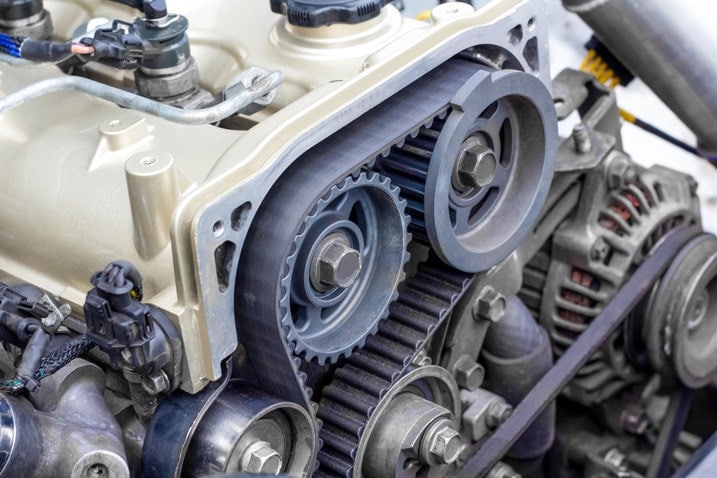Photo: Toa55 | iStock via Getty Images
A timing belt is a thick rubber belt (or a chain on some models) in a vehicle's engine that synchronizes the rotation between the crankshaft and the camshaft. Timing belts are incredibly strong and resilient, often lasting in excess of 100,000 miles, but like all moving parts, they can wear out and, in the worst-case scenario, cause engine failure.
In this scenario, you're likely to receive a scary estimate from your mechanic to replace the timing belt and related components. But what exactly is a timing belt, why is it so important, and why does it cost so much to replace? Staring down a big bill like that can leave you wondering if replacing your timing belt is worth the time and expense or if you can ignore it until it breaks and then fix it. Spoiler alert: You shouldn’t! We will show you not only what a timing belt is and does but also why it’s a bad idea to delay the repair.
Serpentine belt vs. timing belt
Timing belts are similar to serpentine belts, which help power devices such as alternators, air conditioners, and power steering pumps. Both follow a very specific path around several gears and pulleys and require a preset amount of tension to function properly. Where a serpentine belt has ribs that run along its length, a timing belt has teeth that run across it to lock it in place.
What does a timing belt do?
As the name suggests, a timing belt controls the timing of the engine's valves. Valve timing is how engineers make sure that a car’s pistons never run into its intake or exhaust valves. The valves are opened and closed by a camshaft, and the camshaft needs to know where the engine’s crankshaft (and hence its connecting rods and pistons) are in its cycle of rotation so it knows when each piston is at the very top of its stroke. The thing linking the camshafts to the crankshaft is typically either a rubber timing belt or timing chain.
If the timing belt on your engine breaks and your car has what’s called an interference engine — which means that the pistons and valves utilize the same space in the combustion chamber but at different times — the piston can run into the valves, causing catastrophic damage to the engine. Sounds bad, right? It is.
Why is a timing belt so expensive to replace?
On most cars, replacing a serpentine or "accessory" belt like the one that drives your alternator and A/C compressor isn’t all that expensive, so what makes a timing belt replacement different? It's often the cost and time of the labor needed to complete the job.
For starters, the timing belt is much more difficult to access. To gain access to the timing belt on most vehicles, the mechanic must remove everything from the front of the engine. This often includes the alternator and A/C compressor or an engine-driven fan or power steering pump. It also means you typically need to drain the vehicle's coolant because, in many cases, the timing belt drives the water pump.
Once the accessories are removed, the mechanic usually has to remove a timing cover to see the belt. Then, the mechanic needs to use special tools to lock the camshafts and crankshaft in place so that the engine doesn’t go out of time, which is what we’re trying to prevent in the first place. Once that’s done, swapping the belt out is relatively simple.
Like a lot of the most expensive repairs on a car, a timing belt service is mostly labor, but there are also a lot of “while you’re in there” jobs that should be performed as preventive maintenance while the engine is torn down. For example, if the timing belt drives your water pump, this is a good time to replace it. Most timing belt part kits come with not only the belt but also with idler and tensioner pulleys, but if not, you’ll want to replace those as well.
Timing belt cost
According to a report from CNBC, parts and labor costs have been rising overall due to demand and inflation. Timing belt replacement costs will vary by brand, model and region, but you can roughly expect to pay anywhere from $500 to upward of $1,000. If the job involves replacing adjacent serpentine belts and parts, the repair cost can increase closer to $2,000.
Should you care which type of timing belt a car has?
Most modern vehicles have a traditional timing belt. The best way to be certain is to check the owner’s manual and look for the maintenance section. That should not only tell you if you have a timing belt but how often it needs to be changed.
Whether you should buy a car with a timing belt instead of a timing chain or even a gear drive system (these are rare), it’s not something you realistically need to worry about. Each method of valve timing has its pros and cons. Timing chains, for example, might not have a fixed replacement interval, but they do stretch, and plastic parts in the system can degrade, causing problems. They are also often more expensive to service. Gear-driven timing systems are ultra-robust, but modern ones are expensive and usually only found on extremely high-performance vehicles.
Timing belts have been around for a long time, and they are a well-known and established technology. The belts themselves have improved over time, too, thanks to the inclusion of materials like Kevlar into the belt, adding considerable life and strength. Premature failures of belts are pretty much unheard of on their own, too, so don’t lose any sleep over that. Follow your car’s recommended maintenance schedule, and you’ll be OK for hundreds of thousands of miles.
